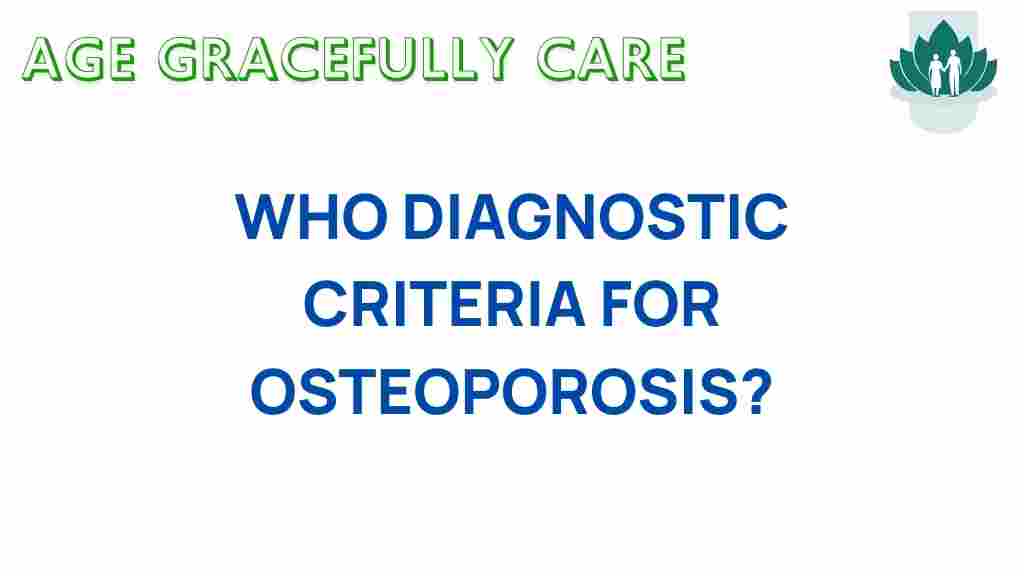Unveiling the WHO Diagnostic Criteria for Osteoporosis: What You Need to Know
Osteoporosis is a silent disease that weakens bones, making them fragile and more likely to fracture. Understanding the WHO criteria for diagnosing osteoporosis is crucial for early detection, effective treatment, and prevention. This article will delve into the WHO diagnostic criteria, health guidelines, risk factors, and more to help you navigate the complexities of osteoporosis.
Understanding Osteoporosis
Osteoporosis affects millions of people globally, particularly older adults. It is characterized by low bone mass and deterioration of bone tissue, leading to increased bone fragility. Given its prevalence, knowing the diagnostic criteria is essential for both patients and healthcare providers.
The WHO Diagnostic Criteria for Osteoporosis
The World Health Organization (WHO) has established specific criteria for diagnosing osteoporosis, primarily based on bone mineral density (BMD) measurements. These criteria allow for consistent diagnosis and help guide treatment decisions. Here’s a breakdown:
- Normal Bone Density: A T-score of -1.0 or higher.
- Low Bone Mass (Osteopenia): A T-score between -1.0 and -2.5.
- Osteoporosis: A T-score of -2.5 or lower.
- Severe Osteoporosis: A T-score of -2.5 or lower with one or more fragility fractures.
The T-score compares an individual’s bone density with that of a healthy young adult. Understanding these classifications is vital for assessing your risk and determining necessary interventions.
Risk Factors for Osteoporosis
Identifying risk factors is crucial in preventing osteoporosis. Various factors can contribute to the development of this condition:
- Age: The risk increases as you get older.
- Gender: Women are at higher risk, especially post-menopause.
- Family History: A family history of osteoporosis elevates your risk.
- Body Frame Size: Smaller body frames may have a higher risk due to less bone mass.
- Hormonal Levels: Low estrogen in women and low testosterone in men can affect bone density.
- Diet: Insufficient calcium and vitamin D intake can contribute to bone loss.
- Lifestyle Factors: Sedentary lifestyle, excessive alcohol consumption, and smoking can increase risk.
Diagnosis of Osteoporosis
Diagnosis typically involves a combination of medical history, physical examination, and diagnostic tests. The following steps outline the diagnosis process:
- Medical History: Your healthcare provider will assess your medical history, including any previous fractures, family history of osteoporosis, and lifestyle factors.
- Physical Examination: A physical exam may reveal signs of osteoporosis, such as loss of height or kyphosis (hunchback).
- Bone Mineral Density Test: A dual-energy X-ray absorptiometry (DEXA) scan is the standard test used to measure bone density and calculate T-scores.
- Risk Assessment Tools: Tools such as the FRAX tool can estimate the 10-year risk of fracture based on various risk factors.
Once diagnosed, your healthcare provider can discuss treatment options tailored to your needs.
Health Guidelines for Osteoporosis
The WHO and other health organizations provide guidelines to help manage osteoporosis effectively. Here are key recommendations:
- Regular Screening: Individuals at risk should undergo regular bone density screenings.
- Calcium and Vitamin D: Ensure adequate intake of calcium (1,000 – 1,200 mg/day) and vitamin D (600 – 800 IU/day).
- Exercise: Engage in weight-bearing and muscle-strengthening exercises to promote bone health.
- Fall Prevention: Implement strategies to reduce fall risk, such as home modifications and balance training.
- Medication: Discuss with your healthcare provider whether medication is necessary based on your risk factors.
Prevention of Osteoporosis
Preventing osteoporosis involves lifestyle changes and proactive health measures. Consider the following strategies:
- Nutrition: Focus on a balanced diet rich in calcium and vitamin D.
- Physical Activity: Aim for at least 30 minutes of weight-bearing exercise most days of the week.
- Avoid Smoking: If you smoke, seek help to quit, as it significantly increases the risk of osteoporosis.
- Limit Alcohol: Reduce alcohol intake to moderate levels (one drink per day for women and two for men).
- Regular Check-ups: Monitor your bone health with your healthcare provider, especially if you have risk factors.
Treatment Options for Osteoporosis
Once diagnosed, treatment can help manage osteoporosis effectively. Options may include:
- Medications: Bisphosphonates are commonly prescribed to prevent bone loss. Other options include hormone therapy, selective estrogen receptor modulators (SERMs), and denosumab.
- Calcium and Vitamin D Supplements: If dietary intake is insufficient, supplements may be recommended.
- Physical Therapy: Tailored exercise programs can enhance strength and balance, reducing the risk of falls.
- Lifestyle Modifications: Implementing healthy lifestyle changes is crucial for treatment effectiveness.
Troubleshooting Tips for Osteoporosis Management
Managing osteoporosis can be challenging. Here are some troubleshooting tips:
- Stay Informed: Continuously educate yourself about osteoporosis and its management.
- Communicate with Your Healthcare Provider: Keep an open line of communication regarding any side effects or concerns with medications.
- Set Realistic Goals: Set achievable health goals, such as incorporating more physical activity into your routine.
- Seek Support: Join a support group or connect with others who have osteoporosis for shared experiences and advice.
Conclusion
Osteoporosis is a serious health condition that requires awareness and proactive management. Understanding the WHO criteria for diagnosis, recognizing risk factors, and following health guidelines can significantly impact your bone health. By implementing preventive measures and seeking appropriate treatment, you can mitigate the effects of osteoporosis and maintain a healthy, active lifestyle.
For more information on bone health and osteoporosis, visit the National Osteoporosis Foundation. Always consult with your healthcare provider to develop a personalized plan that suits your needs.
This article is in the category Health and created by AgeGracefullyCare Team
